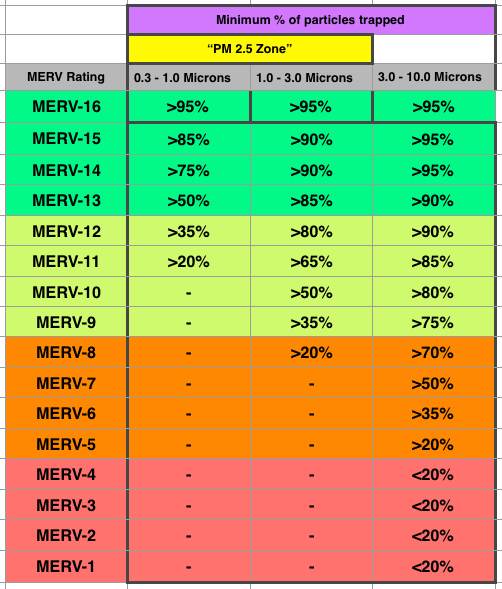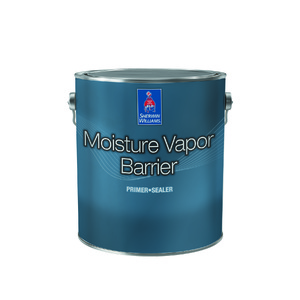
As much as I’ve written about filters and filtration in this blog, I have to confess there’s one aspect of filter efficiency I’ve resisted learning about. Every article I’ve written that mentions filter efficiency talks about only one rating scale: Minimum Efficiency Reporting Value (MERV). A couple of other scales are in common use, too, but I just didn’t want to know anything about them because I buy and recommend MERV rated filters. But I took the plunge recently, and here’s what I found out about the three main filter rating systems.
Minimum Efficiency Reporting Value – MERV
The standard rating system for filters is called Minimum Efficiency Reporting Value, or MERV. When I say it’s the “standard” rating system, I mean it. This rating system is defined in an ASHRAE standard (52.2), which specifies the conditions under which the testing must be done and the performance required to meet each MERV level. Higher-MERV filters remove more particles from your air. They also remove smaller particles. A standard fiberglass one-inch filter is typically a MERV-2. The high end of the scale is MERV-16.
Before we go further, we need to define the three general size ranges of particulate matter (PM).
- PM10 – 3.0 to 10.0 microns
- PM2.5 – 1.0 to 3.0 microns
- PM1.0 – 0.3 to 1.0 micron
The words making up the MERV acronym are a bit unwieldy—what did you expect from engineers?—but the “minimum efficiency” part is the most important. For a filter to get the MERV-13 rating, for example, it must filter out a minimum of 90% of the PM10, a minimum of 85% of the PM2.5, and a minimum of 50% of the PM1.0. Below is a chart from John Semmelhack showing the percentage of particles removed by size range of particle and the MERV rating of the filter.

As you can see, you’ve got to step up your filter game to at least MERV-10 to get even half of the PM2.5. But you really should think of MERV-13 as the minimum because it removes more than 85% of those particular little bitty invisible pieces of stuff. For the COVID-19 pandemic of 2020, ASHRAE has started recommending at least MERV-14.
Filter Performance Rating – FPR
The Home Depot sells a lot of filters. Rather than use MERV ratings, though, they decided to create their own rating system. The details of their testing are a bit murky, as their website explains it in broad strokes only. They look at how well a filter catches both large and small particles and rank the filters on a 1 to 10 scale. From that, they reduced the scale to four numbers (4, 7, 9, or 10), with that rating coming from this weighted average:
Sixty percent of the rating is determined by the filter’s ability to capture large particles, thirty percent is determined by its ability to capture small particles and weight gain over the filter’s lifetime determines the final ten percent.
Here are the four FPR ratings you’ll find on filters:
- 4 Good
- 7 Better
- 9 Best
- 10 Premium
They must be using a different definition for the word “best” than the one I’m familiar with because their premium is better than best.
If you’re wondering how FPR compares to MERV, the Home Depot website has a section on that. They start by saying, “FPR-10 is similar in strength to MERV-20, since they are both the highest rating value.” Some filters on their website that have both an FPR and a MERV rating, and at least one with an FPR of 10 is shown as equivalent to either MERV-8 or MERV-13. (See screenshot below.)

They don’t provide easily available information on the sizes of what they call large and small particles so it’s hard to know what you’re getting with a particular FPR rating. When you combine that with the difficulty of comparing FPR to MERV, it seems the best you can do with this scale is to use it as a rough guide. And if you want to filter out as much of the PM2.5 as you can, stick with the FPR-10 or find one that also has a MERV rating and go with MERV-16.
Microparticle Performance Rating – MPR
As with Home Depot’s Filtration Performance Rating, the Microparticle Performance Rating was developed by a company with a financial interest in the sale of filters. In this case, it’s 3M, the maker of the Filtrete line of filters. Unlike the FPR, though, the MPR measures the effectiveness of a filter’s capturing only the smallest particles on the MERV scale: 0.3 to 1.0 microns. Their website says, “Your filter’s MPR (Microparticle Performance Rating) indicates its ability to capture tiny particles between 0.3 and 1 micron in size.”
Chances are good, though, that if a filter captures a lot of the small particles, it will capture even more of the larger particles. The scale just won’t tell you anything about how well it does with particles larger than 1.0 micron. And we should note that 2.5 microns, the upper limit of PM2.5, is in the group of larger particles not covered by MPR. Apparently they do measure the larger particles, however, because they have a page comparing MPR to MERV, and there you can download a table of capture efficiency data showing the three ranges of particle sizes used in the MERV scale.
The MPR system, like the other two, uses a numerical scale on which higher numbers indicate better filtration. The MPR scale, however, uses much larger numbers. Their basic filter is rated at 100 and their most efficient filter is rated at 2800. The MPR-2800 would qualify as a MERV-14, so even though 3M emphasizes the smallest size range of particles, their best filter doesn’t qualify for the highest MERV rating.
My recommendation…
Buy filters with a MERV rating whenever possible. All three ratings have their problems but even Home Depot and 3M admit on their websites that MERV is the industry standard for rating filters. Also, if you want the filter to improve your indoor air quality and not just protect the heating and air conditioning system, go with MERV-13, FPR-10, MPR-1900, or higher. But make sure you can do that without reducing air flow and possibly damaging your system.
Allison Bailes of Atlanta, Georgia, is a speaker, writer, building science consultant, and founder of Energy Vanguard. He is also the author of the Energy Vanguard Blog. You can follow him on Twitter at @EnergyVanguard.
Weekly Newsletter
Get building science and energy efficiency advice, plus special offers, in your inbox.















6 Comments
The MERV rating on a filter reflects the performance a particular duct velocity (which is supposed appear on the label). There are no fewer than 7 standard speeds at which a filter can be tested for a MERV rating, ranging from 118 fpm (0.60 meters/second) up to 748 fpm (3.80 meters/second). They're not all tested at the same speed, and it matters.
Filters will underperform their MERV rating if the velocity is higher than tested, and outperform their MERV rating if the velocity is much lower. A high MERV at a 118 fpm isn't a useful way to gauge performance in a system running at 700 fpm. A lower MERV number tested at 630 fpm will outperform it's rating by quite a bit on systems running at <400 fpm.
So I dug into this in my home a little while ago. I dropped a mpr 1500 Into my 16x20 return boot (moving About 800 cfm, about 380 fpm)
Tested the pressure drop across it, pulled it out and replaced it with an mpr 1100 or whatever they say mercy 8 is equivalent to.
The pressure drop was THE SAME. I tried it a couple times. On my next filter change I’m going to repeat the experiment with Merv 8 and 11 and see if there’s a difference but my initial impression is that MPR is BS.
if there is not change in deltaP then there can’t be a change in material density. if there’s no change In density how can it acheive better filtration?
Another interesting thing. I left the mpr 1500 in for a while and I started getting a faint mold smell while the blower was running.(I have water problems in the basement which are on the agenda...) I checked my coil for biohazards and found it was spotless so I put in the 1100 and the mold smell went away.
Somebody should test these things in a controlled environment for kicks and giggles but my hillbilly test Suggests to me that at least 3m is BSing.
>"if there is not change in deltaP then there can’t be a change in material density. if there’s no change In density how can it acheive better filtration?"
The pressure difference doesn't necessarily track with filtration effectiveness. Different materials have different amounts of "cling", and at <400 fpm the pressure difference would never be very high until the filter is pretty clogged up. There are MERV 13 filters with much higher delta-Ps than other MERV 13 filters, right out of the box- it's useful to look up the manufacturer's data on that.
Higher performance filters can collect organic material (to grow mold on) more quickly than lower performance filters.
From 3M's website:
"Microparticles are not even measured on the MERV scale until it reaches MERV 11."
Man do I ever hate marketing. The truthful statement is, "Filters with a MERV rating below 11 have lower than 20% capture efficiency between 0.3 and 1.0 microns."
The reality is furnace filters are very high margin products that are very profitable to sell, and companies like Home Depot don't do much in the way of providing useful information to the customer. With their huge buying power it would be very simple to have 3M put a MERV rating on the product, but that would only make cross-shopping that much easier.
Two other standard that correlate and have been in the news lately might be supplemented here: NIOSH and HEPA.
HEPA is used for laboratory/medical facilities where clean air is critical. That standard filters 99.97% of particles diameter 0.3 μm (beyond MERV).
NIOSH N95 is 95% efficient at 0.3 μm (MERV-16). N100 achieves 99.97% filtration (same as HEPA).
The famous virus is 0.060–0.120 μm. So none of these filters technically stop it directly. But particles that small usually hitchhike on larger particles. The whole topic of filtration is also quite interesting because instead of acting like a sieve, as we all imagine, there are four different ways the filters do this, as is explained at https://en.wikipedia.org/wiki/HEPA#Mechanism.
“[Deleted]”
Log in or create an account to post a comment.
Sign up Log in